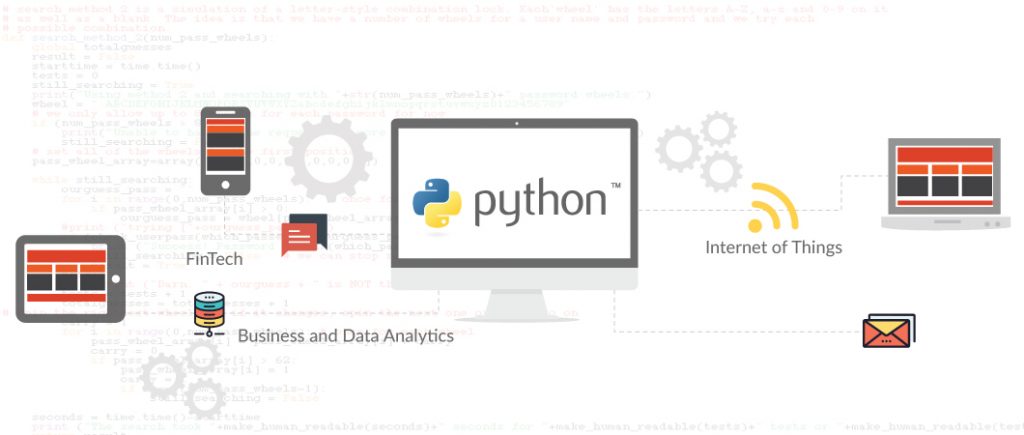Last updated on May 3rd, 2024
Code Eval, the platform for developer challenges publishes a ranking of the most popular programming languages in the year, based on their analysis of over 1.2 million submissions. They found that Python was the most popular coding language of 2016, used by 26% of the programming community across the globe.
Python is an object-oriented programming language which adapts dynamic or execution semantics and emphasizes the growth of information in time. It is one of the most preferred languages for Rapid Application Development due to its built-in features of data structures along with dynamic binding and typing. Python is often the first choice when existing components need to be connected together. Due to its simple, easy to learn, and readable syntax it also helps to decrease the overall time, and hence the cost of program maintenance. It has a focus on modular design and code reuse capabilities. Besides, Python’s extensive source code and binary libraries are available across major platforms which can be also freely distributed. The power of Python has been used for scientific computing and quantitative domains.
It has helped to improve Space Shuttle mission designs and process images from the Hubble Space Telescope. Besides, Python has been used to build greatly scalable web applications like YouTube. Companies like Disney and Sony Dreamworks extensively use Python to produce the imagery for blockbuster movies. Considering its popularity, let’s look at the three major areas where Python seems to have caught fire:
FinTech
Financial technology, also known as FinTech, involves developing software for the financial services sector. Fintech is all about innovating solutions across the lending, banking, and capital markets. Apart from established companies, several startups are now getting into this field, which has led to fierce competition. Due to its easy adaptability, Python is an uncomplicated language to start with. It is also great for solving quantitative problems. Further, Python can also be used to perform automated builds, prototyping, testing, and deployment automation. With this in mind, hedge funds, banks, and trading organizations are transforming to Python from MATLAB and Java-based applications and Python are becoming among the most popular and widely used programming language within this space. Another hot trend in the Fintech sector is for organizations to recruit Python developers for interest rate derivatives platform. This has translated into a huge demand for software developers with Python knowledge.
Internet of Things
Internet of Things (IoT) has revolutionized the way devices or objects interact with each other. Combined with the power of Python, one can quickly build interactive objects and design them. The boom in IoT technology has thus created a huge opportunity for Python programmers. The IoT hardware platforms, as well as micro-controllers like Raspberry Pi, Intel Galileo, and Arduino, have built-in interaction capability. This helps make Python a key skill in this field. For instance, Raspberry Pi is a credit-card-sized single-board computer developed by the Raspberry Pi Foundation.
It supports Python as its primary programming language and hence allows the developers to build their own devices like cameras, phones, games, and radios using Python with ease. With advanced Python programming, developers also customize their own gadgets and connect them with real-world markets.
Business and Data Analytics
‘Data science’ or Business Analytics, has become critically important for organizations in today’s competitive times. Data science is used to interpret large sets of complex and unstructured data into a simpler and meaningful form. Python is now the preferred choice of language for big data and business data analytics. It can be used to build high-performance tools which help in efficient data structuring, data manipulation, query, data analysis, and visualization. Using Python, data can be converted into meaningful business insights which can eventually drive a competitive advantage. Python was originally a general programming language like C, C++, and Java. However, in the course of time, Python has now developed dedicated libraries, for data analysis and predictive modeling. The most commonly used libraries include NumPy, Matplotlib, Pandas, Statsmodels, and Scrapy to name a few.
Python is easy for data analysts and scientists to learn and use. It integrates well with the existing IT infrastructure and is platform-independent at the same time. No wonder, businesses are now relying on Python to manage their data.
The primary reason for Python’s popularity is its simplicity and ease of use. The syntax is more English-driven rather than machine language. With its enormous libraries, it is definitely a trailblazer and trendsetter for many organizations to developers. The popularity of Python seems set for an uptrend even in the days to come!



